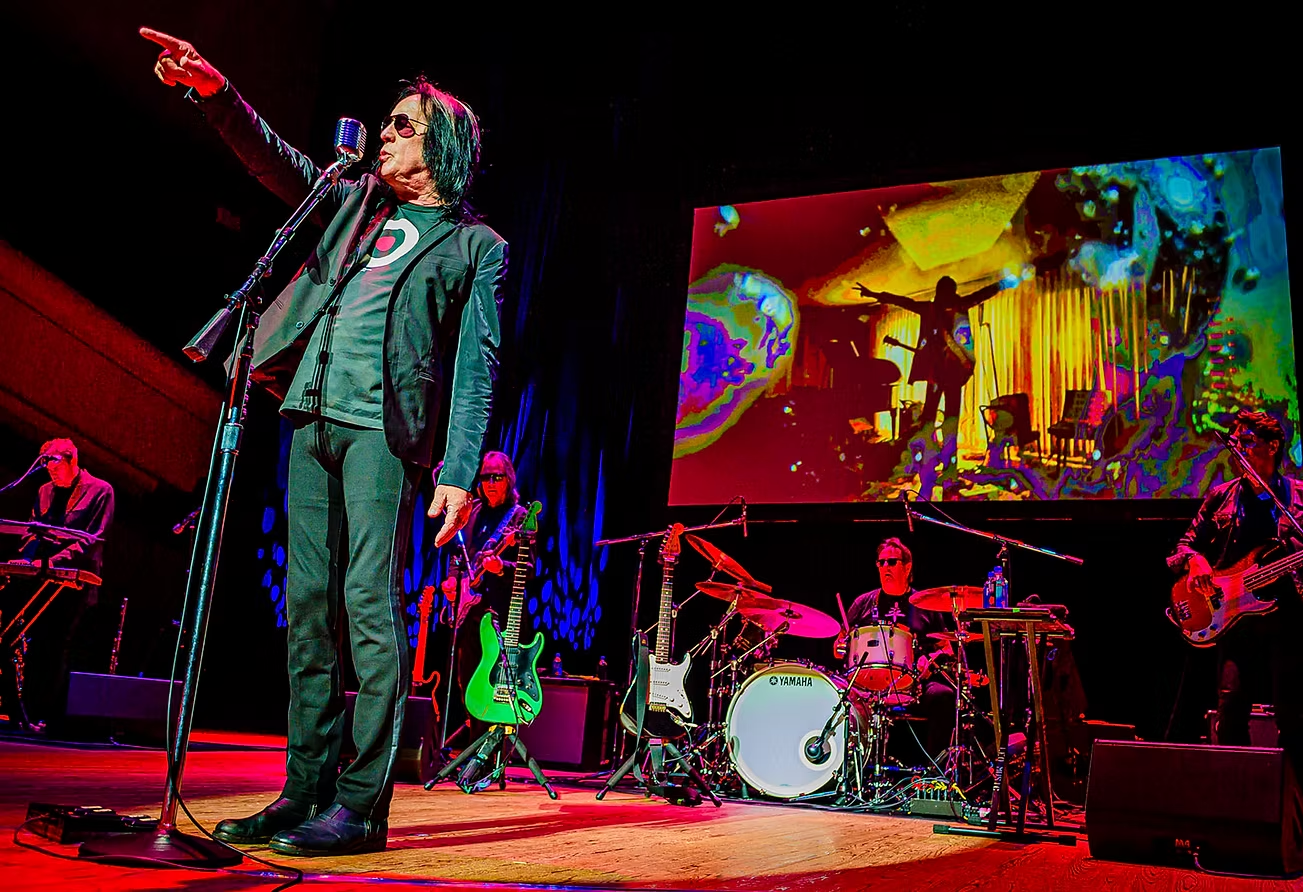
Story: Dave Gil de Rubio
In the annals of popular music, you’d be hard-pressed to find an artist as eclectic and prolific as Todd Rundgren. To call him creatively restless is like calling The Beatles a quaint pop band.
As a solo artist, he’s notched 27 releases (with the most recent being 2022’s Space Force). And that doesn’t include projects he’s recorded as a member of The Nazz, Utopia and the New Cars. As if that’s not enough, the Pennsylvania native has an equally impressive résumé as a producer, having worked on albums for a number of seminal artists ranging from Badfinger (“Straight Up”), the New York Dolls (self-titled, “Cause I Sez So”) and Meat Loaf (“Bat Out of Hell”) to Grand Funk Railroad (“We’re An American Band,” “Shinin’ On”), XTC (“Skylarking”) and the Psychedelic Furs (“Forever Now”).
But for the man who once released an album called “The Ever Popular Tortured Artist Effect,” performing live does just as much as studio work to satiate his creative urges with the most recent road jaunt being the Me/We Tour. And while recent live outings have found him going from performing 25 virtual shows from Chicago in the immediate aftermath of the pandemic to opening for fellow Keystone stater Daryl Hall, this current string of dates finds Rundgren doing something specifically for his devotees.
“I figured when it was time for me to get to doing my tour, I want to give the fans something special and figure out some sort of sustainable production that can travel, but it’s still a show that’s worth coming out for,” he said in an early April interview. “I figure one of the things that I may not have done recently is a real deep dive of a lot of the stuff that rarely gets played or has never been played. A lot of it is fan favorites, but sometimes I can’t figure out how it will fit into what I’m doing. I think it’s going to be a very enjoyable evening for the fans despite the fact that for at least some segment of them, a lot of the material might be unfamiliar.”
While a quick peek at Rundgren’s set list from some recent gigs reveals that he’s been trotting out well-known gems like “Hello It’s Me,” “I Saw the Light” and “Can We Still Be Friends,” the former “Hermit of Mink Hollow” promises to dust off a number of more obscure nuggets.
“I had never played the song ‘Afterlife’ before. It’s from the album called ‘Liars,’ but it didn’t work in the context of the show, so we never performed it during the ‘Liars’ show,” he explained. “I just did a brief [swing through] Australia and we worked it up for that tour and it really sounded great. It sounded really good and the audience liked it. ‘Liars’ was a pretty popular album among my fans. To find a song that hadn’t been played off of that was a little special.”
So where does Rundgren’s insatiable need to embrace the various aspects of the recording studio and any sort of emerging technology as a means of helping realize his artistic visions come from? Part of it starts with a childhood growing up in Upper Darby Township, PA, where early on, the budding creative genius started out being enraptured by his parents’ singles collection.
“The earliest musical memories I have are of a little RCA 45 player that my parents got. I remember it to this day,” he recalled. “It was a brown Bakelite with a little round grill on the front and a spindle with the red top on it. And you would stack singles on the spindle and they would automatically play one after another. My parents had collected a lot of Boston Pops light classical performances like ‘Chicken Reel’ and ‘Skaters Waltz’ and that sort of thing. They were pressed on colored vinyl—red, green, blue and yellow. For me, listening to the music on that little player and staring through the red, blue and green record or putting one on top of the other—it was [my first] multi-media experience.”
“Sometimes what you do doesn’t fit with the zeitgeist of what’s going on. They say art is brief and history is long. The point is that you don’t do your art for this time. Do it in a way that it doesn’t matter when somebody discovers it. That way, maybe you’ll have a longer life as an artist.”

While the young Rundgren spent time dabbling with various instruments including flute, clarinet and his grandmother’s stand-up piano (“it’s where I learned how to pick out melodies, which I actually turned out to be pretty good at”), it was a specific instrumental that led to his parents purchasing their budding musician son an instrument when he was seven years old.
“Once I heard ‘Walk, Don’t Run’ by The Ventures, it was all about the guitar,” Rundgren explained. “That was the future and I knew I had to learn how to play. My parents realized that I wanted to do it badly enough and that I was serious that they bought a guitar, but they had to buy lessons along with it, which I hated.”
Within a year of graduating high school, Rundgren went from his first band Money to playing with the Paul Butterfield Blues Band-influenced Woody’s Truck Stop and eventually landing with rock band Nazz. Looking to record material more along the lines of The Who and The Beatles, Rundgren and his crew were signed by Atlantic Records subsidiary Screen Gems Columbia (SGC). Assigned jazz musician Bill Traut as a producer for the 1968 self-titled debut album (“…he [Traut] essentially spent most of his time reading the trades in the [recording] booth.”), Rundgren soon took it upon himself to remix the album himself because “…we didn’t get what we wanted out of this guy even though we paid for him.”
Rundgren’s first turn at a console was the beginning of a storied production career that while he was technically proficient at, wasn’t level with his interactions with some of the artists whose projects he oversaw, most notably XTC.
“I knew how to make records and how to make them sound a certain way, but as time went on, there were a lot of painful moments between me and whoever I was working with because I was either incognizant or didn’t care about the personality part,” he admitted.”
With so much life experience under his belt, the 76-year-old Rundgren shows no signs of slowing down. And much of it has to do with his willingness to follow his own muse.
“I think what I’ve learned is, and it seems especially applicable these days is that you don’t measure your success by others’ estimation and you have to be patient,” he said. “Sometimes what you do doesn’t fit with the zeitgeist of what’s going on. They say art is brief and history is long. The point is that you don’t do your art for this time. Do it in a way that it doesn’t matter when somebody discovers it. That way, maybe you’ll have a longer life as an artist. A lot of artists feel like if they don’t make it now, they’re never going to make it. It’s still an interesting experience for me. I don’t feel like I would run out of musical ideas. At least not in a reasonable human lifetime.”
